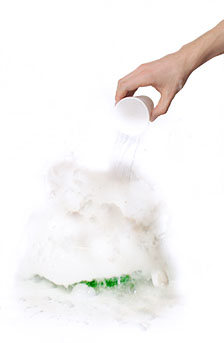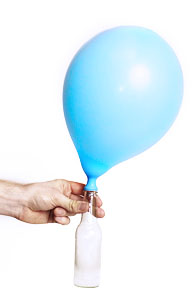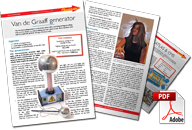Liquid nitrogen
Liquid nitrogen, boiling furiously despite being hundreds of degrees below freezing, is thoroughly captivating. You can make a whole show with this stuff, so Accelerate! concentrates on the safety and engineering challenges of using cryogenic liquids.
Apparatus
A few litres of liquid nitrogen
1 × bunch of flowers
1 × small bowl
Warm water
Washing up liquid
1 × glass bottle
1 × balloon
1 × length of rubber tubing
Safety
These demonstrations also illustrate why safety is of paramount importance when dealing with nitrogen in a science show. Always be sure to wear appropriate clothing and use safety equipment when handling it. The greatest risk from liquid nitrogen is probably asphyxiation, resulting from a large volume of nitrogen gas displacing oxygen in the room. Be sure to conduct a risk assessment in conjunction with your local safety office before using or transporting liquid nitrogen.
The demonstrations
The first two of these are done by audience volunteers, so get a couple down and kit them out with safety visors and cryogenic-safe non-porous gloves.
Smashing flowers
- Give the first volunteer a bunch of flowers and encourage them to dunk them into a bucket of liquid nitrogen.
- When the boiling stops, get them to pull the flowers out and smash them (hard!) onto a nearby surface.

Nitrogen bubbles
- Give the second volunteer a polystyrene cup filled with nitrogen, and get them to throw it all into a bowl containing warm, soapy water.
- Watch as a cloud of steam clears to leave a huge mass of bubbles.
Filling a balloon
- Place a small volume of liquid nitrogen in the bottom of a glass bottle.
- Stretch a balloon over the neck of the bottle. The balloon will fill up with nitrogen gas, probably enough to explode it, or at least make it fly off comically around the room.
Smashing rubber
- Take a length of rubber tube and place one end in a bucket of liquid nitrogen. Liquid nitrogen will spray spectacularly out of the other end, so be careful where you point it!
- When the spraying stops, the tube will be at the same temperature as the nitrogen. Remove it, and tap it on a nearby surface to demonstrate that its properties have changed somewhat…
- Smash it with a hammer!
Vital statistics
boiling point of nitrogen:
−196°C (77 K)
expansion from liquid to gas:
600 to 700 times
How they work
These four demonstrations are centred on three basic concepts relating to liquid nitrogen, and cryogenic liquids in general.
Extreme cold and living tissue
The first is one of the safety issues of dealing with the extremely cold: if it comes into contact with anything biological, from a bunch of flowers to the human body, it can very rapidly freeze the water inside and between the cells, thus killing them and also making the tissue very brittle. The flowers can be smashed: since you would likely have the restraint not to do the same to your finger, the more likely consequences are severe frostbite. That’s why we have to be careful with these cryogens, wearing safety gear when handling them but, more importantly, trying to make sure they don’t come into contact with people at all.
Liquid–gas expansion

The second is the massive expansion as you change a liquid into a gas. Liquid nitrogen has a density a little lower than water, but when it vapourises that density immediately drops several-hundredfold. Then, as it warms to room temperature, it expands by a further factor of three or so (its temperature changes from 77 K to 300 K, and we know that ideal gases’ volumes are proportional to their temperatures). The end result is an expansion of 600 to 700 times as liquid nitrogen is warmed. That’s why a huge, foaming tower of bubbles can be created from just a cupful of nitrogen and, slightly more quantitatively, why a whole balloon can be more than filled with a tiny amount of nitrogen in the bottom of a bottle.
The engineering implications of this are that any heat leak in a piece of cryogenic apparatus can be catastrophic: the gas produced from a large volume of liquid cryogen can be enormous, and in an enclosed space without appropriate safety valves, could cause an explosion!
Material properties at low temperature
The final point is that materials’ properties can be radically altered by cooling to nitrogen temperatures: in the case of the flower, that was simply water freezing, but rubber remains solid whilst changing from flexible to rather glassy. This means we have to take care when designing these machines that the materials we use will work as expected at low temperatures. For example, using rubber seals on a machine containing liquid nitrogen would obviously be a bad idea because the rubber becomes very brittle and might shatter, and could no longer contain the liquid.
Cryogenics in the LHC
In the LHC, the extreme cold is required to keep the superconducting magnets working. In fact, the superconductor used wouldn’t function at liquid nitrogen temperatures, and instead liquid helium is used.
Helium boils at just 4.2 K, or around −269°C. Further, the pressure above the liquid is lowered by pumping and this reduces its temperature even more, to a rather chilly 1.9 K. The ‘cosmic microwave background’, an electromagnetic echo from the Big Bang which permeates the Universe, is at 2.7 K, which gives rise to the claim that the inside of the LHC is ‘colder than outer space’.



